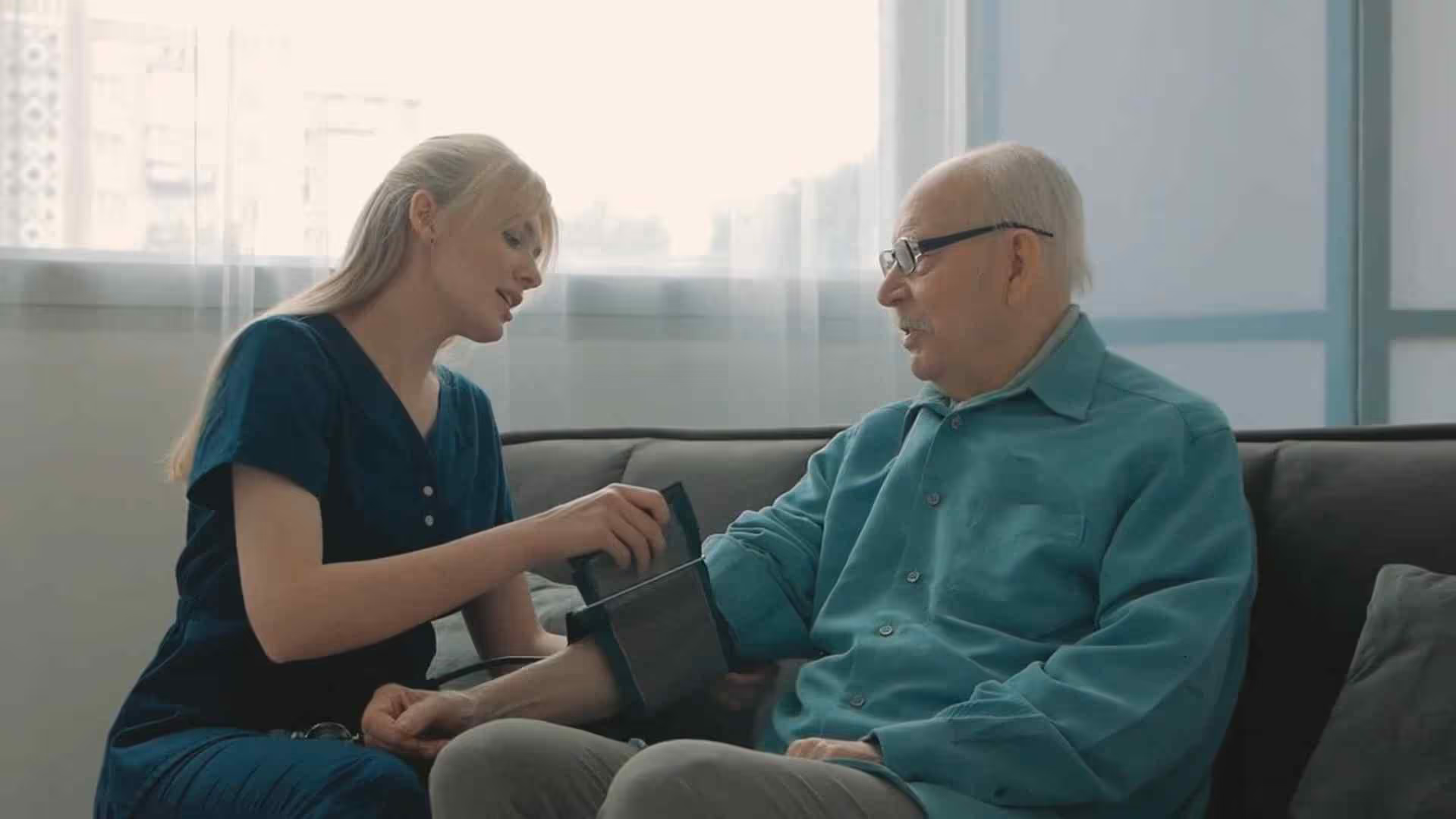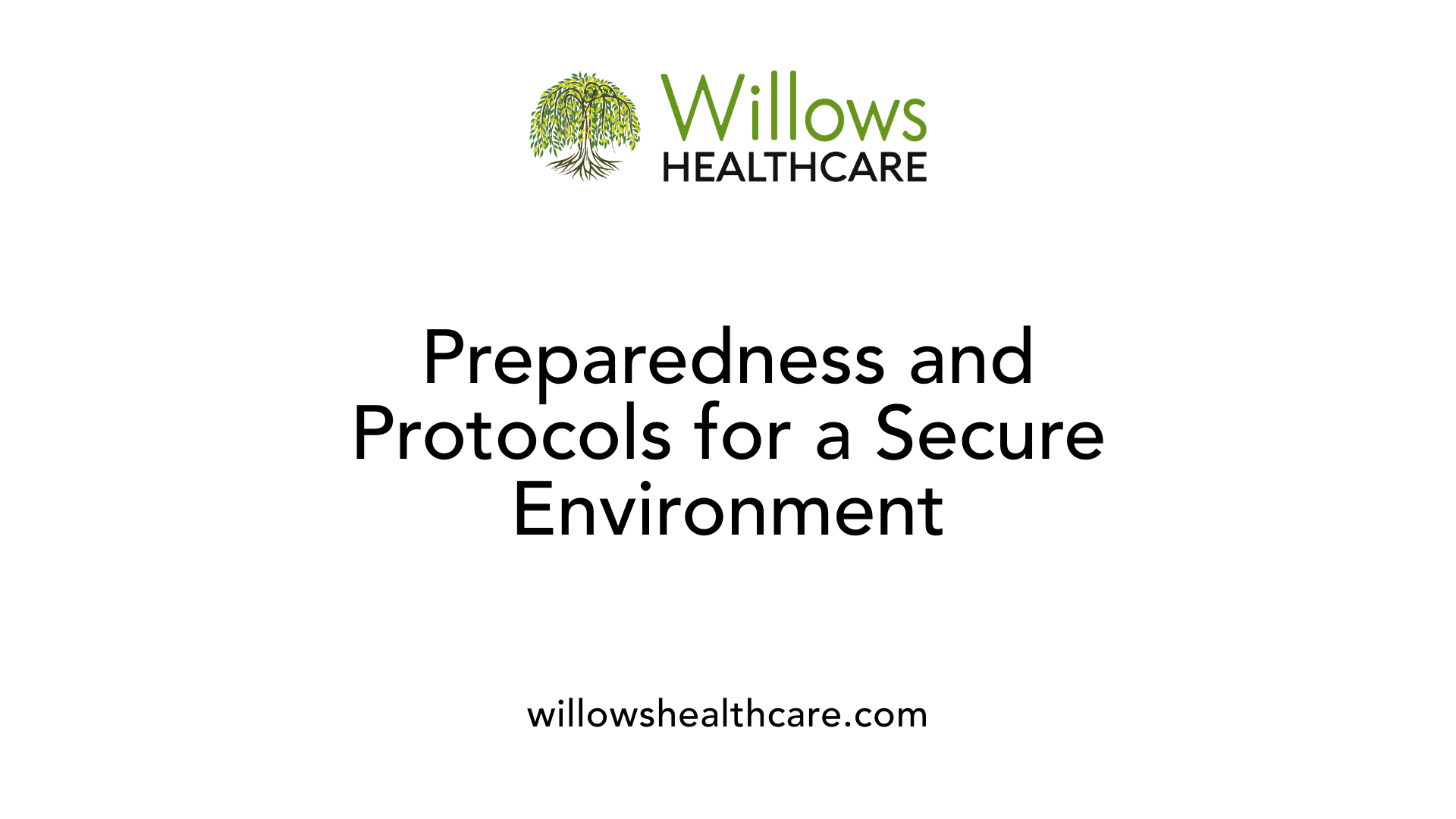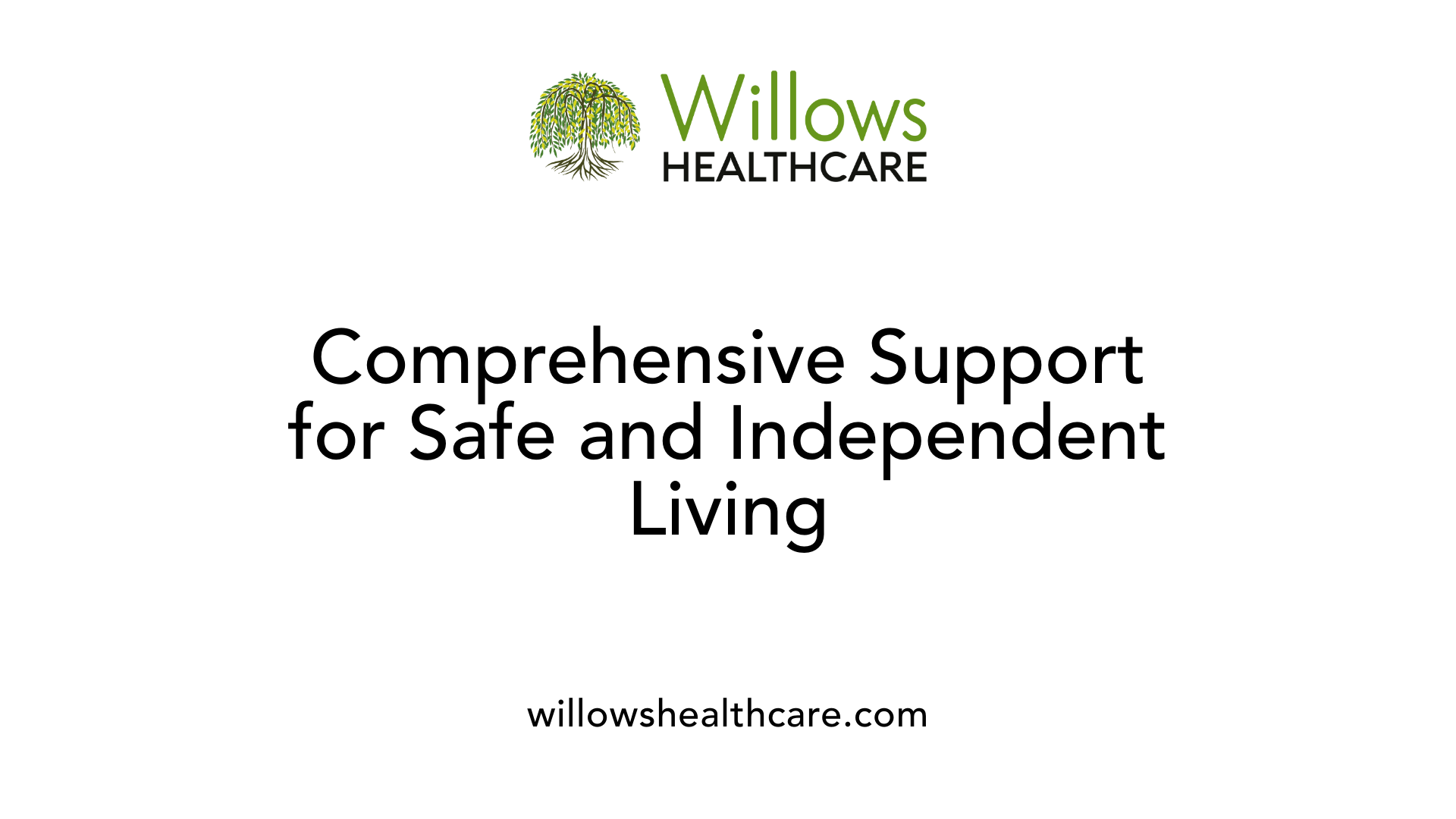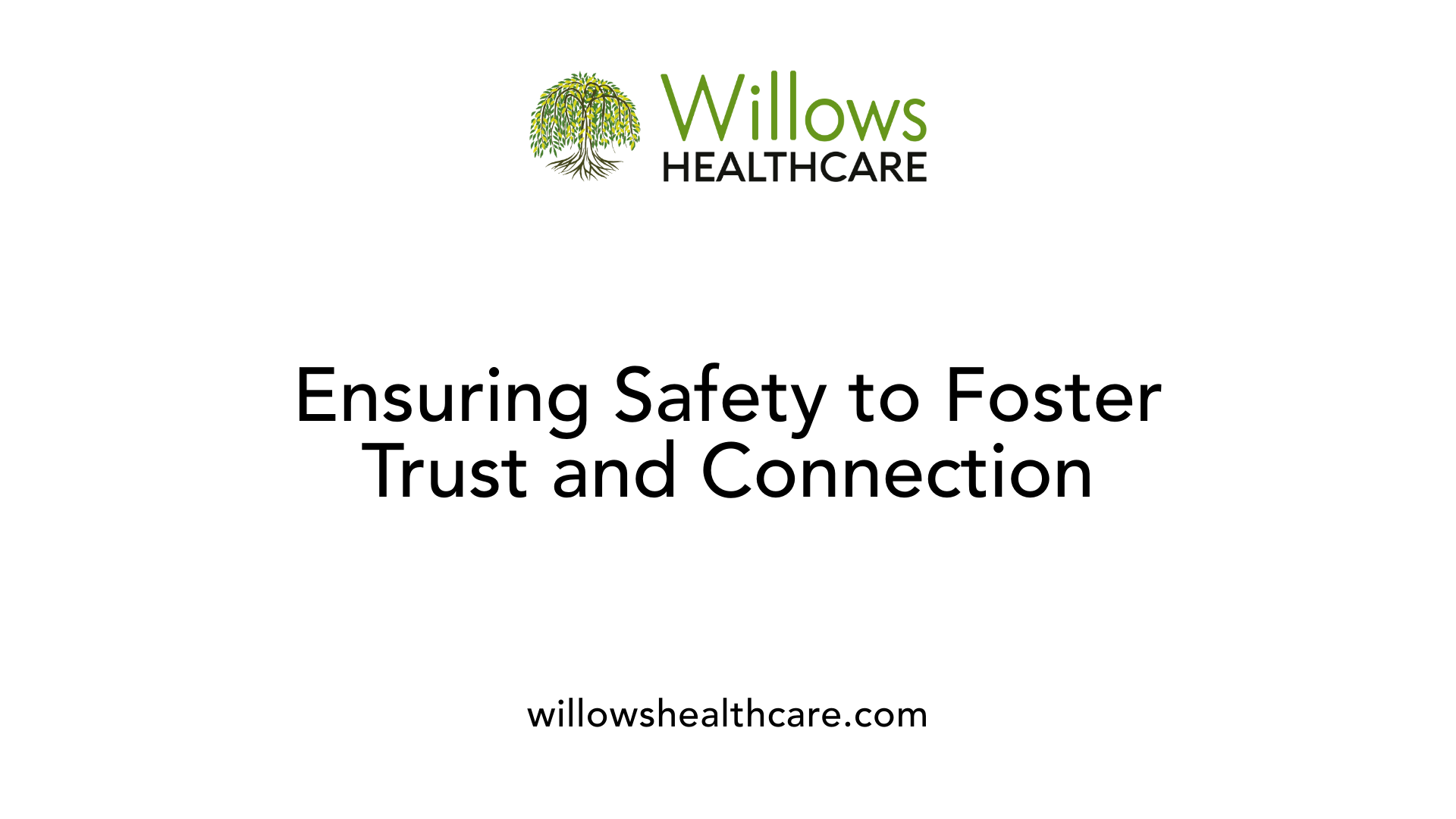How Willows Healthcare Ensures Seniors Have a Safe Living Environment
July 7, 2025
Guarding Seniors with Comprehensive Safety Strategies


Ensuring Safety and Well-Being for Elderly Residents
Willows Healthcare prioritizes creating a secure, supportive environment where seniors can maintain independence, enjoy social engagement, and receive personalized care. Through a combination of advanced safety features, tailored care practices, and community support, the facility exemplifies a holistic approach to senior safety and quality of life.
Personalized Care and Environment Customization

How do care practices promote safe living environments for elderly residents?
Senior care providers prioritize safety through tailored care practices that consider each resident's unique health needs and personal circumstances. One fundamental approach involves creating individualized safety plans that address mobility limitations, chronic conditions, and specific risks. This means environmental modifications like installing sturdy handrails along stairways and in bathrooms, using non-slip flooring throughout living areas, and ensuring proper lighting to eliminate shadows and trip hazards.
Medication management and routine health assessments are essential to prevent emergencies and monitor health status. Regular communication with healthcare professionals ensures that medication regimens are appropriate, and any necessary adjustments are made promptly. Safety also extends to fire prevention and toxin control by deploying smoke detectors, carbon monoxide alarms, and secure storage of hazardous materials.
Fostering an environment where social engagement and emotional support are actively encouraged enhances overall well-being. Open dialogues among residents, staff, and families build trust and create a community atmosphere that feels safe and welcoming. By combining physical safety features with personalized care and emotional support, assisted living facilities can effectively reduce risks and promote a secure, supportive environment.
How are living spaces personalized for residents?
Residents' living areas are designed to reflect their personal tastes and belongings, making the environment feel like home. This involves allowing residents to bring in personal furniture, photographs, and cherished possessions, which reinforces their sense of identity and independence. Personalization supports emotional well-being and helps residents feel comfortable and familiar in their surroundings.
In addition, accommodations are planned with accessibility in mind. Units may include features like wide doorways, accessible bathrooms, and lever-style door handles. Such design elements are critical in supporting residents' ability to navigate their space safely while maintaining independence.
What accessibility features are incorporated into unit design?
Accessibility is a cornerstone of safe senior living environments. The design of units typically includes features such as low-threshold or no-threshold entryways, walk-in showers with grab bars, and easy-to-reach storage options. These elements help prevent falls and make daily activities easier.
Furthermore, flooring materials are chosen for their slip-resistant qualities, and lighting is optimized to eliminate dark spots.
| Aspect | Implementation | Purpose |
|---|---|---|
| Grab Bars | Installed in bathrooms, near beds | Support mobility and prevent falls |
| Non-slip Flooring | In kitchens, bathrooms, hallways | Reduce slip and trip hazards |
| Adequate Lighting | Bright, adjustable lights | Improve visibility and safety |
| Accessible Doors | Wider doorways, lever handles | Ease of entry and exit |
| Clear Pathways | Decluttered walkways, no rugs | Minimize trip risks |
By thoughtfully integrating these safety measures alongside personalized living spaces, assisted living facilities create environments that safeguard residents' health while fostering dignity and independence.
Safety Features and Facility Design

What safety features are typically included in assisted living and memory care facilities?
Assisted living and memory care centers prioritize resident safety by incorporating various protective features into their design and operations. Common safety elements include controlled access points that prevent unauthorized entry, ensuring that only residents, staff, and approved visitors can enter or leave the premises.
To monitor activities and deter incidents, facilities often install surveillance cameras in hallways, common areas, and outdoor spaces. Adequate lighting in these areas helps reduce the risk of trips and falls.
Non-slip flooring is a standard feature throughout the facility, especially in bathrooms, kitchens, and entryways, to minimize fall hazards. Likewise, grab bars, handrails, and ramps are strategically placed in bathrooms and along hallways to support mobility and stability.
Emergency call systems are essential components; residents typically wear pendant alarms or have pull cords in their rooms and bathrooms to summon assistance quickly.
Fire safety is a top priority, with smoke detectors, sprinkler systems, and fire extinguishers regularly maintained and tested to ensure effectiveness.
Staff members are trained in safety procedures, emergency response, and first aid to respond swiftly to accidents or health crises. Routine wellness checks help monitor the residents’ well-being and prevent potential emergencies.
Outdoor safety features include gated entrances, security patrols, and well-maintained walkways. These help prevent residents from wandering off or encountering outdoor hazards.
Overall, these safety measures create a secure environment that promotes confidence and peace of mind for residents, families, and staff alike.
Safety Protocols and Emergency Preparedness

What safety measures and protocols should senior living facilities have in place?
Senior living communities must prioritize resident safety by establishing comprehensive safety protocols that address a variety of risks. These measures not only prevent accidents but also ensure quick and effective responses to emergencies.
One of the most important safety features is fall prevention. Facilities incorporate strategies such as well-lit corridors, handrails along stairways and hallways, non-slip flooring, and accessible bathrooms with grab bars. Regular wellness checks by trained staff help identify residents at risk of falls or health deterioration, allowing for timely interventions.
Fire safety is another critical aspect. Most facilities are equipped with smoke detectors, sprinkler systems, and fire extinguishers located throughout the building. Clear evacuation routes, illuminated exit signs, and routine fire drills help ensure residents and staff are prepared in case of an emergency.
Security measures are vital for preventing unauthorized access and managing resident safety. This includes electronic perimeter controls, surveillance cameras, and wander management systems for residents with memory care needs. Staff training in emergency response procedures ensures a quick and organized reaction during crises.
Proper medication management is also essential. Facilities implement systems for safely administering and monitoring medications, reducing errors and adverse effects. Personalized safety checklists for each resident help in maintaining continuous safety oversight.
Finally, maintaining high hygiene standards, regular safety audits, and open communication channels promote a safe, supportive environment. When combined, these safety protocols foster peace of mind for residents and their families, contributing to overall well-being and security.
Support Services Enhancing Safety and Well-Being

What support services are offered to enhance safety for seniors in care facilities?
Seniors in care facilities benefit from a range of safety support services designed to promote independence and reduce the risk of accidents. One fundamental service is the installation of emergency monitoring systems, which operate 24/7 through certified operators. These systems include medical alert devices such as Home Alert systems, Mobile GPS alerts, and GPS-enabled smartwatches, allowing seniors to access help quickly if needed.
Beyond technological aids, healthcare providers often perform home safety assessments to identify potential hazards. These assessments, conducted by organizations like Homewatch CareGivers, focus on hazard removal—installing grab bars, fixing uneven flooring, and ensuring adequate lighting—to prevent falls and injuries.
Community-based programs add an extra layer of security. The Chicago Department of Family & Support Services, for example, offers in-home care, adult protective services, and well-being checks. These programs aim to protect seniors from abuse, neglect, and exploitation by maintaining regular contact and monitoring their environment.
Safety measures also include physical safeguards like functional fire alarms and carbon monoxide detectors, along with fire extinguishers, which are essential in any care setting.
Combining advanced technology, proactive home safety strategies, community support initiatives, and emergency preparedness ensures a comprehensive approach to safeguarding the health and safety of seniors. This integrated support system helps seniors live independently with confidence and peace of mind.
Fostering Emotional Well-Being Through Social Engagement

Why is maintaining a safe environment important in senior care facilities?
Creating a secure setting in senior care facilities is vital for protecting residents from accidents like falls, burns, and medication mistakes, which can lead to severe health issues. Safety features such as handrails, non-slip flooring, well-lit hallways, emergency call systems, and accessible bathrooms help residents navigate confidently and independently.
A safe environment also boosts residents' confidence and encourages social interaction, which benefits their mental health. When seniors feel secure, they are more likely to participate in activities, form social bonds, and maintain an active lifestyle. This, in turn, reduces feelings of fear, loneliness, and depression.
Facilities often implement staff training, emergency preparedness, and active participation in Patient Safety Organizations (PSOs). These steps support continuous risk assessment, sharing of best safety practices, and rapid response during emergencies.
Overall, safety isn't just about preventing injuries; it fosters a sense of dignity, promotes independence, and enhances overall well-being, making senior care environments welcoming and supportive.
A Secure and Compassionate Environment for Seniors
Willows Healthcare exemplifies a holistic approach to senior safety by integrating personalized care, advanced safety features, responsive emergency protocols, and engaging social programs. This comprehensive strategy ensures that residents not only live safely but also enjoy a fulfilling, supported, and dignified life. By continually adapting to residents’ evolving needs and fostering a nurturing community, Willows Healthcare remains committed to safeguarding the health, independence, and happiness of every senior in its care.
References
- How Assisted Living Helps Seniors Maintain Independence
- The Benefits of Memory Care and Assisted Living
- How to Help Seniors Transition Back Home After ...
- Willows Health Center | Photos
- The Willows at Bowling Green
- Willow Park Nursing Home: Comprehensive Care Insights
- The Willows at Hamburg | Lexington, KY
- care for seniors in Willow Springs, IL
- Falls in the Elderly at Home – Common Causes & Prevention













